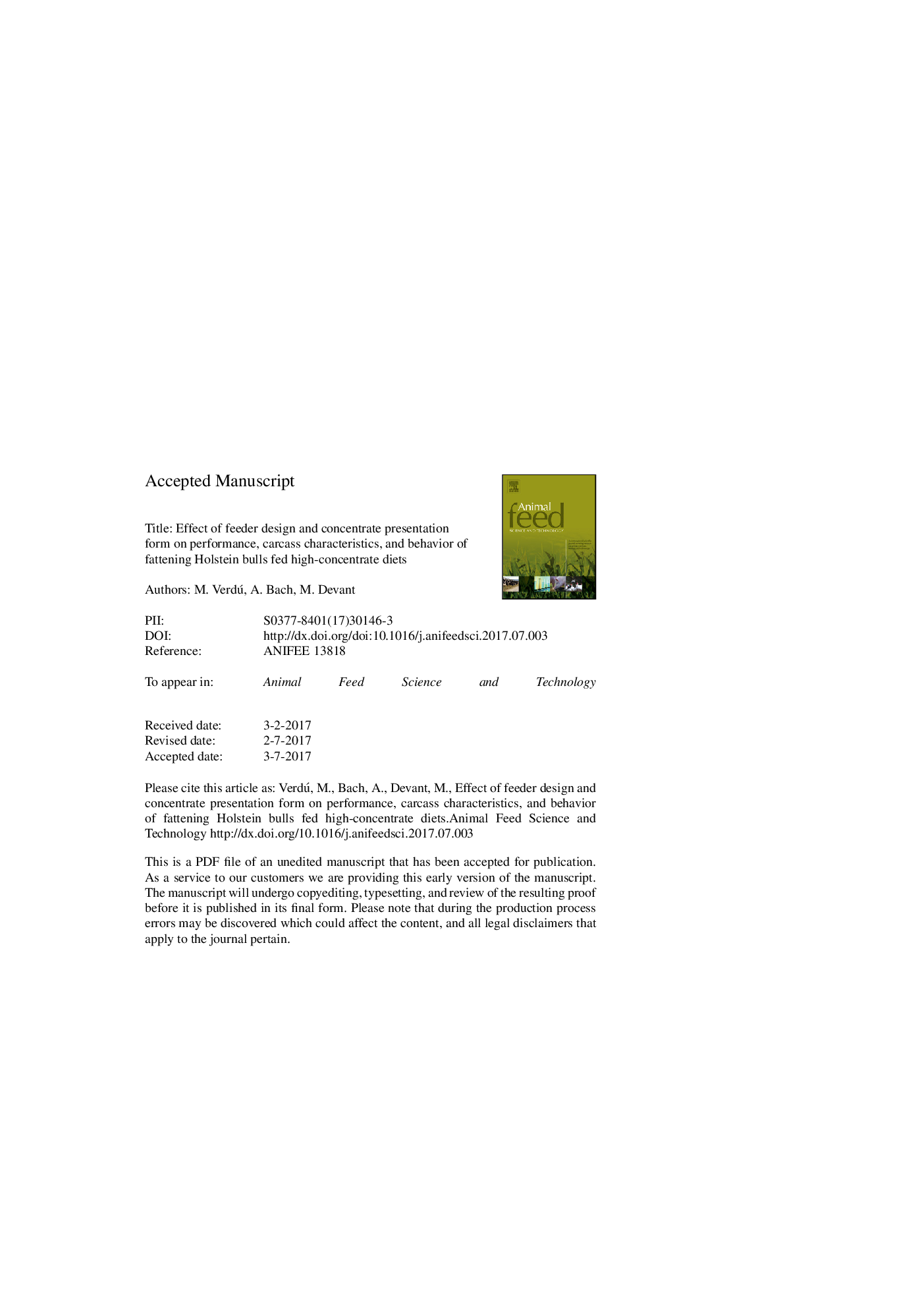| کد مقاله | کد نشریه | سال انتشار | مقاله انگلیسی | نسخه تمام متن |
|---|---|---|---|---|
| 5538670 | 1552354 | 2017 | 29 صفحه PDF | دانلود رایگان |
عنوان انگلیسی مقاله ISI
Effect of feeder design and concentrate presentation form on performance, carcass characteristics, and behavior of fattening Holstein bulls fed high-concentrate diets
ترجمه فارسی عنوان
اثر طراحی فیدر و فرم ارائه کنسانتره بر عملکرد، ویژگی های لاشه و رفتار گوسفند گاوهای هولشتاین تغذیه با رژیم های حاوی کنسانتره بالا
دانلود مقاله + سفارش ترجمه
دانلود مقاله ISI انگلیسی
رایگان برای ایرانیان
کلمات کلیدی
گوشت گاو، رفتار - اخلاق، لاشه، شکل ارائه غلظت، طراحی فیدر، کارایی،
موضوعات مرتبط
علوم زیستی و بیوفناوری
علوم کشاورزی و بیولوژیک
علوم دامی و جانورشناسی
چکیده انگلیسی
The study objective was to evaluate the effect of feeder design and concentrate presentation form on performance, carcass characteristics, and animal behavior in fattening Holstein bulls fed high-concentrate diets. A total of 294 bulls (175 ± 6.5 kg of BW and 139 ± 0.7 days of age) were randomly allotted to one of 16 pens (18-19 bulls per pen) distributed in 2 barns (8 pens per barn). Each pen was assigned to one of 4 treatments following a 2 Ã 2 factorial arrangement of treatments: feeder design (collective vs. single) and concentrate presentation form (meal vs. pellet). Collective feeder consisted of three feeding spaces with a concentrate feeder capacity of 40 kg; and single feeder consisted of one single-space feeder with lateral protections, forming a chute, with a feeder capacity of 10 kg. Pen concentrate consumption was registered daily, straw consumption weekly, and BW fortnightly. Animal behavior was registered at day -6, 1, 3, 6, 9, 13, 29, and every 28 days thereafter. The chute of the single-space feeder was not placed to facilitate the feed access for the first 28 days of study (receiving period). During this period, only the concentrate presentation form was evaluated. Animals were slaughtered after 182 days, and HCW, carcass quality and liver lesions were recorded. Three fattening periods were established according to days of the study and animal BW: receiving (28 days; from 175 to 220 kg), growing (98 days; from 220 to 360 kg), and finishing (56 days; from 360 to 430 kg). The effects of feeder design and concentrate presentation form on performance differed depending on fattening period; however, no relevant effects on animal behavior were observed. During the receiving period, calves fed pellet exhibited greater (P < 0.01) growth than those fed meal. Throughout the growing period, concentrate efficiency tended (P = 0.09) to be greater in animals fed pellets in collective feeder, followed by those fed pellets in a single feeder, and, lastly, by those fed meal regardless of the feeder design. During the finishing period, concentrate intake was lesser (P < 0.01) and concentrate efficiency tended (P = 0.07) to be greater in bulls fed pellets compared with those fed meal. Bulls fed pellets in collective feeders tended (P = 0.10) to have greater HCW. In conclusion, the best strategy to improve performance and concentrate efficiency is to feed animals in a collective feeder and present the concentrate in pellet form. Moreover, a single-space feeder with lateral protections was not a good strategy to diminish concentrate wastage, observed in a reduction of total concentrate intake, and improve concentrate efficiency during the finishing period when feeding meal.
ناشر
Database: Elsevier - ScienceDirect (ساینس دایرکت)
Journal: Animal Feed Science and Technology - Volume 232, October 2017, Pages 148-159
Journal: Animal Feed Science and Technology - Volume 232, October 2017, Pages 148-159
نویسندگان
M. Verdú, A. Bach, M. Devant,
